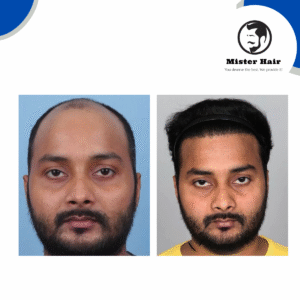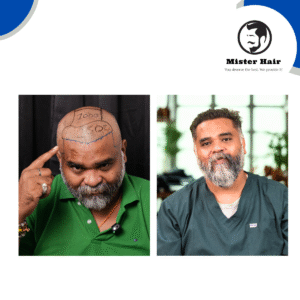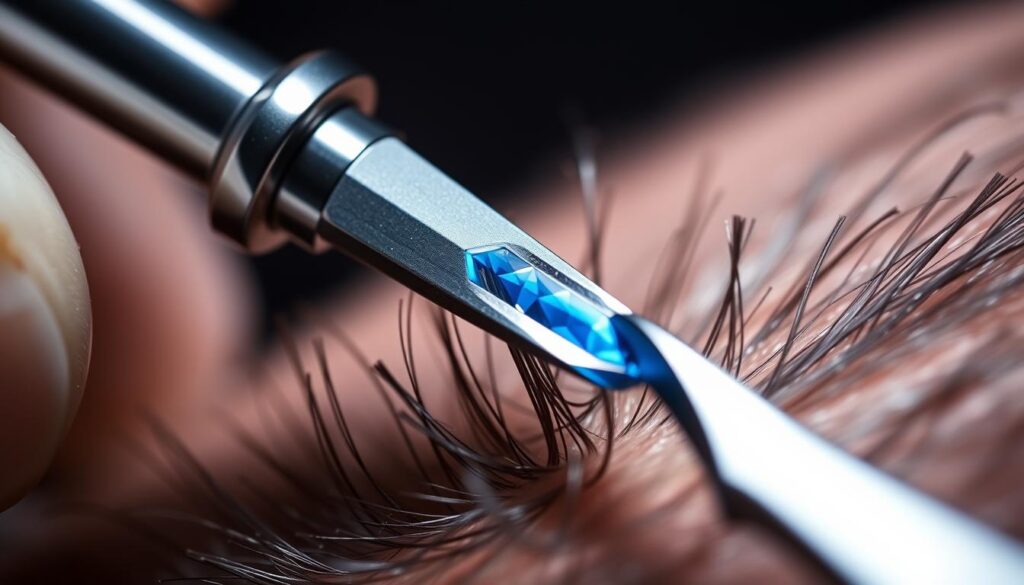Sapphire blade hair restoration technology delivers unparalleled precision in follicle placement, fundamentally transforming the aesthetic outcomes of hair transplant procedures.
The sapphire blades create much finer incisions compared to traditional steel instruments, allowing surgeons to make smaller, more controlled cuts in the recipient area.
This enhanced precision enables transplanted follicles to be positioned at the optimal angle and direction, perfectly mimicking natural hair growth patterns.
The rounded edges of sapphire blades facilitate shorter incisions while resulting in significantly less trauma to the scalp. Due to this precision, surgeons can create many tiny incisions that are very close together, allowing for the placement of more hair follicles in a designated area.
This capability translates to higher density coverage when reforming balding areas, as more follicular grafts can be positioned close together compared to traditional FUE techniques.
The fine nature of sapphire blade incisions ensures that transplanted hair grows in a natural direction, contributing to a more aesthetically pleasing hairline and overall appearance.
These specialized tools can be shaped with small, fine tips that create smaller micro channels, accommodating hair follicles of varying sizes regardless of thickness or texture.
Reduced Tissue Damage and Faster Healing
Now that we understand the precision benefits, sapphire FUE technology significantly minimizes tissue trauma during the transplantation process. The fine incisions created by sapphire blades cause considerably less damage to surrounding scalp tissue compared to steel blade alternatives, resulting in a faster recovery period for patients.
The reduced trauma translates directly into accelerated healing times, with most patients able to return to work within just a few days following the procedure.
This faster application of hair transplantation also speeds up the overall recovery process, allowing individuals to resume their normal routines more quickly than with conventional methods.
The minimally invasive nature of the sapphire FUE technique means patients experience less swelling, bleeding, and scabbing post-procedure.
The smaller incisions heal more efficiently, contributing to minimal scarring that often becomes virtually invisible after the healing process is complete.
This reduced tissue damage also results in less post-operative discomfort, making the entire experience more tolerable for patients seeking hair restoration solutions.
Lower Risk of Complications and Infections
With this enhanced healing profile in mind, sapphire blades offer superior safety advantages that significantly reduce complication risks. The sapphire material demonstrates exceptional resistance to bacterial retention, which substantially lowers the risk of post-surgical infections compared to traditional steel instruments used in conventional FUE procedures.
The durability and wear resistance of sapphire blades make them ideal for delicate hair transplant procedures, maintaining their sharpness and smoothness throughout the entire surgical process.
This consistency prevents the blade degradation that can occur with steel instruments, ensuring optimal incision quality from start to finish.
The precision cutting capability of sapphire blades reduces the likelihood of follicle damage during implantation, which directly correlates to lower complication rates.
The smoother incisions created by sapphire technology heal more predictably, minimizing the risk of irregular scarring or healing complications that can sometimes occur with less precise instruments.
For More information contact us : 91 8553954466
Higher Graft Survival Rates and Density
Previously established precision and safety benefits culminate in superior graft survival rates with sapphire hair transplant technology. The gentle extraction and implantation process enabled by sapphire blades ensures that harvested follicles experience minimal trauma, significantly improving their viability and long-term survival prospects.
The ability to create smaller, more precise recipient sites allows for optimal follicle placement without compromising blood supply to surrounding tissue.
This enhanced technique preserves the delicate vascular network necessary for graft survival, resulting in higher success rates for transplanted hair follicles.
Sapphire FUE enables surgeons to achieve greater hair density in treatment areas due to the precision of micro-channel creation. The technique allows for more follicular grafts to be placed closer together without compromising individual graft survival, delivering fuller, more natural-looking results.
The permanent solution provided by sapphire FUE ensures that transplanted follicles, taken from genetically resistant donor areas, will continue growing naturally for a lifetime when properly maintained.
Comparing Sapphire FUE to Other Hair Restoration Methods

Sapphire FUE vs Traditional Steel Blade FUE
When evaluating sapphire FUE versus traditional steel blade FUE, the fundamental difference lies in the surgical instrument used during the procedure.
Traditional FUE techniques employ steel-based blades to create recipient site incisions, while sapphire FUE utilizes specialized sapphire surgical blades with a distinctive V-shaped design that allows for enhanced precision and control during the transplantation process.
The sapphire blade’s superior design results in significantly smaller and more precise incisions compared to steel blades. This advancement translates to minimum trauma and scarring at the recipient site, making sapphire FUE the next evolution of traditional hair transplant techniques.
Patients experience less bleeding during the procedure, and the enhanced precision contributes to more natural-looking results with increased hair density in areas of hair loss.
Recovery times between both methods are comparable, with both offering fast recovery processes. However, sapphire FUE demonstrates superior outcomes in terms of scarring minimization and overall aesthetic results due to the enhanced surgical blade technology.
Sapphire FUE vs DHI (Direct Hair Implantation)
The comparison between sapphire FUE and DHI reveals distinct procedural differences that affect patient selection and outcomes.
DHI utilizes a specialized tool called the Choi Implanter Pen, which allows hair follicles to be extracted and implanted with the same device using different attachments. This technique eliminates the need for incisions entirely, resulting in virtually invisible scarring at donor sites.
Key procedural differences include:
Aspect Sapphire FUE DHI Graft capacity per session 5000-6000 grafts 1500-3500 grafts Hair shaving requirement Full head shaving Only donor area Control over hair direction Slightly less control Superior control over angle, direction, and depth Scarring Minimal scarring Virtually invisible scarring Procedure intensity Less labor-intensive More labor-intensive
DHI offers superior control over hair growth direction and is particularly suitable for candidates with longer hair who prefer to maintain their existing hairstyle.
The technique allows for more precise placement regarding angle, direction, and depth of transplanted hairs, making it ideal for patients seeking specific styling outcomes.
Conversely, sapphire FUE excels in treating larger transplant areas and can handle significantly more grafts per session. Both techniques boast success rates exceeding 95%, with faster recovery processes compared to older FUT methods.
Sapphire FUE vs Diamond FUE Method
While the reference content primarily focuses on sapphire FUE comparisons with steel blade FUE and DHI techniques, the diamond FUE method represents another advanced hair restoration approach.
Both sapphire and diamond FUE methods utilize precious materials to create superior surgical instruments compared to traditional steel blades.
The sapphire blade’s V-shaped design provides exceptional precision during the creation of micro-incisions in the recipient area. This specialized blade technology contributes to the enhanced surgical outcomes and reduced trauma associated with sapphire FUE procedures.
When Sapphire FUE Is the Best Choice
Sapphire FUE emerges as the optimal choice for specific patient profiles and treatment goals. This technique is particularly well-suited for patients with shorter hair who aren’t as concerned with maintaining specific styling patterns during the recovery period. The method’s capability to handle larger areas of hair loss makes it ideal for patients requiring extensive coverage.
Sapphire FUE is recommended when:
- Patients require treatment of larger transplant areas
- Hair loss covers extensive regions requiring 5000-6000 grafts
- Patients prefer shorter hair or don’t mind full head shaving
- The primary goal is maximum hair density rather than specific directional styling
- Patients seek a less labor-intensive procedure with faster completion times
The technique’s enhanced precision, combined with its ability to achieve natural-looking results and increased density, makes sapphire FUE an excellent choice for patients prioritizing coverage and density over specific hair direction control.
With success rates consistently above 95% and fast recovery processes, sapphire FUE represents a significant advancement in hair restoration technology.
For patients seeking the most advanced FUE technique with superior blade technology, sapphire FUE offers the perfect balance of efficiency, results, and recovery time, particularly when treating larger areas of hair loss.
Preparing for Your Sapphire Hair Transplant Surgery

Essential Medical Examinations and Health Assessments
Before undergoing sapphire hair transplant surgery, a comprehensive initial consultation and assessment forms the foundation of your treatment plan.
Your surgeon will thoroughly evaluate your scalp and analyze your hair loss patterns to determine the most appropriate approach for your specific condition. This assessment includes determining the number of grafts required and establishing realistic expectations for your results.
During this consultation phase, it’s essential to discuss your complete medical history with your surgeon. This includes any current medications, previous surgeries, and underlying health conditions that might affect the procedure or recovery process.
Your surgeon will also assess the quality of your donor area to ensure sufficient healthy hair follicles are available for transplantation.
Lifestyle Changes to Optimize Results
Now that we’ve covered the medical assessment, implementing specific lifestyle modifications before your sapphire FUE method procedure is crucial for optimal outcomes. Smoking cessation represents one of the most critical changes you’ll need to make.
You must refrain from smoking at least two weeks before your sapphire hair transplant, as smoking significantly reduces blood flow, which is essential for proper healing and graft survival.
Alcohol consumption must also be carefully managed in preparation for your procedure. Avoid alcohol for at least one week prior to surgery, as it can interfere with anesthesia effectiveness and compromise your post-surgical recovery process.
Alcohol can also affect blood clotting mechanisms, potentially increasing bleeding risks during the procedure.
Scalp preparation plays a vital role in ensuring successful results. Wash your hair thoroughly with a mild shampoo the day before your surgery to maintain optimal scalp cleanliness.
Your surgeon may recommend specific scalp moisturization techniques to keep your scalp in ideal condition for the procedure.
Pre-Surgery Instructions for Best Outcomes
With proper lifestyle adjustments in place, following specific pre-surgery instructions becomes paramount for achieving the best possible results from your sapphire blade hair restoration procedure.
Medication management requires careful attention – you must discontinue certain medications at least two weeks before surgery.
This includes aspirin and other blood-thinning medications, vitamin E supplements, and fish oil, as these can affect blood clotting and increase bleeding risks during the procedure.
Clothing selection for surgery day should prioritize comfort and practicality. Choose loose, button-up shirts that won’t require pulling over your head, which could disturb the transplanted grafts post-procedure. Avoid tight-fitting hats or headgear that might apply pressure to your scalp.
Mental and physical preparation involves understanding that the hair transplant recovery process can take several hours depending on the number of grafts required. Ensure adequate rest in the days leading up to your procedure, and maintain a calm, stress-free mindset to help your body better handle the surgery.
For More information contact us : 91 8553954466
Setting Realistic Expectations
Previously, we’ve discussed the technical preparation aspects, but setting realistic expectations forms an equally important component of your pre-surgery preparation.
Understanding the timeline for visible results is crucial – transplanted hair typically sheds within the first few weeks as part of the natural growth cycle. This shedding is completely normal and expected.
New hair growth from your sapphire hair transplant typically begins around three to four months after the procedure. However, final results become fully visible after 12 to 18 months, requiring patience throughout the recovery process.
The sapphire blade advantages include more precise incisions and faster healing times compared to traditional methods, but the biological hair growth timeline remains consistent regardless of the technique used.
Cost considerations should also align with realistic expectations. While sapphire hair transplant benefits justify the investment, understanding that this represents a long-term commitment to hair restoration helps establish appropriate expectations for both the financial investment and time required to see complete results.
Post-Surgery Recovery and Aftercare

Immediate Post-Operative Care Instructions
Following your sapphire hair transplant, you’ll receive specific instructions from your surgeon to ensure optimal healing and graft survival. Slight scalp swelling is common after surgery, but this can be effectively managed with simple techniques such as cold compresses and gentle massaging.
To accelerate the healing process, it’s recommended to sleep with your head elevated for a minimum of three days following the procedure.
The first 24-48 hours are critical, as the donor and recipient areas remain sensitive during this period. Tiny scabs will naturally form around the transplanted grafts, and you may experience mild swelling or redness. It’s essential to avoid touching or scratching the treated areas to prevent dislodging the implanted grafts.
Your doctor will prescribe pain medication, antibiotics, and specialized medical shampoos for cleaning the surgical area. Following these instructions strictly is extremely important, as failure to do so may result in unwanted complications that could compromise your success.
Long-Term Maintenance for Optimal Results
Proper aftercare plays a crucial role in the success of your sapphire hair transplant surgery. To avoid dislodging implanted grafts, take a break from strenuous activities like exercise and swimming for a minimum of three weeks to one month.
Many factors can inhibit blood circulation and contribute to blood thinning, including smoking cigarettes, consuming tobacco products, drinking alcohol and caffeine. It’s best to avoid these substances during your recovery period or until you heal completely.
Maintaining good hygiene is essential throughout the recovery process. Avoid harsh weather conditions such as direct sunlight and hair products containing chemicals.
Use a loose-fitting hat to shield the treated area when going outdoors. Getting proper rest also helps accelerate the healing process and supports optimal graft survival.
Expected Timeline from Surgery to Full Growth
The hair transplant recovery process follows a predictable timeline that patients should understand for realistic expectations. During the first week (days 3-7), patients should follow specific washing instructions provided by the clinic.
Gentle washing helps remove scabs without damaging the grafts, and swelling typically subsides during this period.
By day 10-14, most scabs naturally fall off, revealing the transplanted hair. The donor area heals significantly during this time, and many patients can return to their regular routines.
For More information contact us : 91 8553954466
Between 1-3 months post-surgery, patients typically notice the shedding phase, where transplanted hairs fall out as new hair begins to grow from the follicles.
Visible results become apparent at 6-12 months, with thicker and fuller hair growth developing progressively. The final results of your sapphire hair transplant are typically achieved within a full year, demonstrating the natural and long-lasting benefits of this advanced technique.
Managing the Initial Shedding Phase
One of the most common concerns patients have following sapphire FUE hair transplantation is ‘shock loss,’ where sudden hair loss occurs. This phenomenon is completely normal and occurs in almost all hair restoration procedures, so there’s nothing to worry about.
After the hair grafts are implanted, they need time to adjust to their new position, which triggers this temporary shedding.
Your hair will start growing back within six months after experiencing this sudden hair loss. This shedding phase is actually a positive sign that the follicles are responding to their new environment and preparing for healthy new growth.
After a full year, the desired results of your hair transplantation will be clearly evident, with natural-looking, permanent hair restoration achieving the density and coverage you were seeking.

